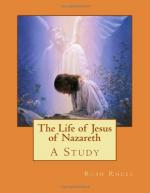80. If John was thus a revival of the older prophetic order, a second question arises: Whence came his baptism, and what did it signify? The gospels describe it as a “baptism of repentance for the remission of sins” (Mark i. 4). John’s declaration that his greater successor should baptize with the Holy Spirit and fire (Matt. iii. 11) shows that he viewed his baptism as a symbol, rather than as a means, of remission of sin. But it was more than a sign of repentance, it was a confession of loyalty to the kingdom which John’s successor was to establish. It had thus a twofold significance: (a) confession of and turning from the old life of sin, and (b) consecration to the coming kingdom. Whence, then, came this ordinance? Not from the Essenes, for, unlike John’s baptism, the bath required by these Jewish ascetics was an oft-repeated act. Further, John’s rite had a far deeper religious significance than the Essene washings. These performed their ablutions to secure ritual cleanness as exemplary disciples of the Mosaic ideal. The searching of heart which preceded John’s baptism, and the radical change of life it demanded, seem foreign to Essenism. The baptism of John, considered as a ceremony of consecration for the coming kingdom, was parallel rather to the initiatory oaths of the Essene brotherhood than to their ablutions. Their custom may have served to suggest to John a different application of the familiar sacred use of the bath; indeed John could hardly have been uninfluenced by the usage of his contemporaries; yet in this, as in his thought, he was not a product of their school.
81. John’s baptism was equally independent of the pharisaic influence. The scribes made much of “divers washings,” but not with any such significance as would furnish to John his baptism of repentance and of radical change of life. That he was not following a pharisaic leading appears in the question put to him by the Pharisees, “Why, then, baptizest thou?” (John i. 25). They saw something unique in the ceremony as he conducted it.




